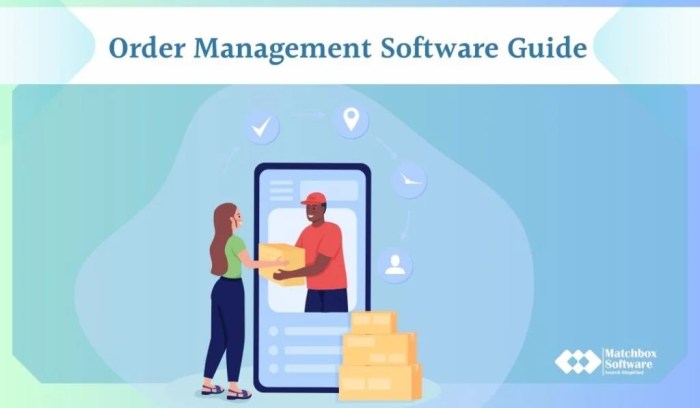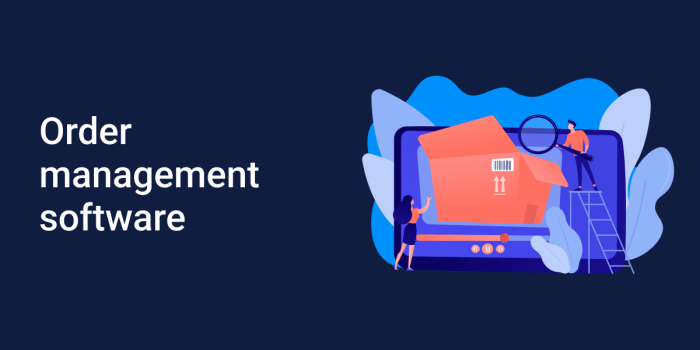Crm and order management software – In today’s fast-paced business environment, efficient management of customer relationships and orders is paramount for success. This is where integrated Customer Relationship Management (CRM) and Order Management Software (OMS) systems become invaluable. This comprehensive guide will delve into the intricacies of both, exploring their individual functionalities, the benefits of integrating them, and how they can streamline your business operations.

Source: matchboxsoftware.com
We’ll also cover key features, selection criteria, and frequently asked questions to help you make informed decisions.
Understanding Customer Relationship Management (CRM) Software
CRM software is a technology for managing all your company’s relationships and interactions with customers and potential customers. The goal is simple: improve business relationships. A CRM system helps companies stay connected to customers, streamline processes, and improve profitability. Think of it as a centralized hub for all customer-related data, interactions, and communications.
Key Features of CRM Software:, Crm and order management software
- Contact Management: Storing and organizing customer information (name, address, email, phone number, purchase history, etc.).
- Sales Force Automation (SFA): Automating sales tasks like lead generation, opportunity tracking, and sales forecasting.
- Marketing Automation: Automating marketing campaigns, email marketing, and social media engagement.
- Customer Service & Support: Managing customer inquiries, resolving issues, and tracking support tickets.
- Reporting & Analytics: Generating reports on sales performance, customer behavior, and marketing campaign effectiveness.
- Integration Capabilities: Connecting with other business applications like email clients, accounting software, and e-commerce platforms.
Types of CRM Software:
- Operational CRM: Automates customer-facing processes like sales, marketing, and customer service.
- Analytical CRM: Analyzes customer data to gain insights and improve decision-making.
- Collaborative CRM: Facilitates communication and collaboration between different departments and teams.
Understanding Order Management Software (OMS)
Order management software (OMS) is a system designed to streamline and automate the entire order fulfillment process, from order placement to delivery. It acts as the central nervous system for managing orders across multiple channels, warehouses, and shipping carriers.
Key Features of OMS Software:
- Order Entry & Processing: Automating order entry from various channels (e.g., online store, phone, email).
- Inventory Management: Tracking inventory levels in real-time across multiple locations.
- Warehouse Management: Managing warehouse operations, including picking, packing, and shipping.
- Shipping & Delivery: Integrating with shipping carriers to generate shipping labels and track shipments.
- Returns Management: Managing customer returns and exchanges efficiently.
- Reporting & Analytics: Providing insights into order fulfillment performance, inventory levels, and shipping costs.
- Integration with other systems: Seamless integration with CRM, ERP, and e-commerce platforms.
Integrating CRM and OMS: The Synergistic Powerhouse
Integrating CRM and OMS creates a powerful synergy, providing a holistic view of the customer journey and enhancing operational efficiency. By connecting these systems, businesses can achieve:
- Improved Customer Experience: Providing personalized service based on customer data and order history.
- Increased Sales & Revenue: Streamlining order fulfillment and improving customer satisfaction.
- Reduced Operational Costs: Automating tasks and minimizing manual errors.
- Enhanced Inventory Management: Optimizing inventory levels and reducing stockouts.
- Better Forecasting & Planning: Making data-driven decisions based on sales trends and customer behavior.
- Improved Visibility & Control: Having a complete overview of the entire order lifecycle.
Examples of Integrated CRM and OMS functionalities:
- Automated order updates: Customers receive automated email notifications about order status changes.
- Personalized recommendations: CRM data can be used to offer personalized product recommendations during checkout.
- Proactive customer service: OMS data can alert customer service about potential delivery delays or issues.
- Targeted marketing campaigns: CRM data can be used to segment customers and target them with relevant marketing campaigns.
Selecting the Right CRM and OMS Software: Crm And Order Management Software
Choosing the right CRM and OMS software requires careful consideration of your business needs and requirements. Key factors to consider include:
- Business Size and Industry: Select software that scales with your business growth and caters to your industry-specific needs.
- Budget: Consider the cost of the software, implementation, and ongoing maintenance.
- Features and Functionality: Choose software with the features that align with your business processes.
- Integration Capabilities: Ensure the software integrates seamlessly with your existing systems.
- Scalability and Flexibility: Choose software that can adapt to your changing business needs.
- User-Friendliness: Select software that is easy to use and understand for your team.
- Vendor Support and Reputation: Choose a reputable vendor with excellent customer support.
Frequently Asked Questions (FAQ)
- Q: What is the difference between CRM and OMS?
A: CRM focuses on managing customer relationships, while OMS focuses on managing the order fulfillment process. While distinct, they work best when integrated. - Q: How much does CRM and OMS software cost?
A: Costs vary widely depending on the features, scalability, and vendor. Expect a range from affordable cloud-based solutions to enterprise-level systems with significant upfront investment. - Q: How long does it take to implement CRM and OMS software?
A: Implementation time depends on the complexity of the software and your business processes. It can range from a few weeks to several months. - Q: What are the benefits of integrating CRM and OMS?
A: Integration provides a 360-degree view of the customer, improves operational efficiency, enhances customer experience, and boosts profitability. - Q: Can small businesses use CRM and OMS software?
A: Yes, many affordable and user-friendly cloud-based solutions are available for small businesses. - Q: What are some popular CRM and OMS software options?
A: Popular CRM options include Salesforce, HubSpot, Zoho CRM. Popular OMS options include NetSuite, Ordergroove, and Shopify.
Conclusion
Implementing a robust CRM and OMS system is a strategic investment that can significantly improve your business operations and customer relationships. By understanding the functionalities of each system and the benefits of integrating them, you can make informed decisions that drive growth and enhance profitability. Remember to carefully evaluate your business needs and select a solution that aligns with your goals and budget.

Source: bordio.com
Call to Action
Ready to streamline your business processes and enhance your customer relationships? Contact us today for a free consultation to discuss your specific needs and explore the right CRM and OMS solution for your business.
FAQ Summary
What are the key benefits of integrating CRM and order management?
Improved customer satisfaction, increased operational efficiency, enhanced data visibility, better inventory management, and ultimately, higher profitability.
How much does CRM and order management software typically cost?
Pricing varies greatly depending on the features, scalability, and vendor. Expect a range from affordable monthly subscriptions for smaller businesses to substantial upfront investments for larger enterprises with complex needs.
What are some common challenges in implementing CRM and order management software?
Data migration issues, user adoption challenges, integration complexities with existing systems, and the need for ongoing training and support are common hurdles.
Can these systems integrate with existing accounting software?
Many CRM and order management systems offer robust integration capabilities with popular accounting software packages, ensuring seamless data flow and financial reporting.
